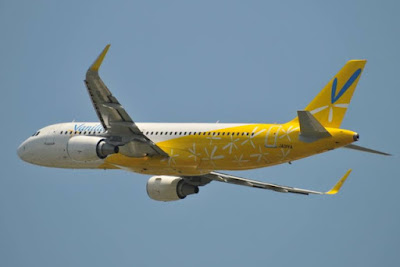Vanilla Air [JW/VNL] will commence Osaka/Kansai [KIX/RJBB] – Taipei/Taoyuan [TPE/RCTP] sometime during the Summer 2016 schedule, which comes into effect on March 27th. Kansai becomes the fledgling LCCs fourth destination in Japan, but the first not originating from or arriving into Tokyo/Narita [NRT/RJAA], where it is based and all flights currently depart from. It has already started hiring ground staff, and descriptions say Chinese fluency is welcomed and initial work would be in the early hours after midnight.
The ANA Holdings' 100% subsidiary LCC currently flies four round-trips between Narita and Taiwan's capital. Its fourth flight out of Narita arrives into Taipei right past midnight, and sits on the ground for approximately six hours until its flight back to Narita, and Vanilla is expected to squeeze a Taipei – Kansai round-trip in that time frame. This is how sister LCC Peach Aviation [MM/APJ], minority owned by ANA, flies into Tokyo/Haneda [HND/RJTT] from Taipei (Peach Aviation inaugurates Haneda – Taipei.) and soon Seoul (Peach Aviation announces Haneda – Seoul.) during the early hours without having to base aircraft there.
Vanilla initially planned to add two Airbus A320s during FY2015, however, that was put on hold with ANA Holdings President Shinya Katanozaka also saying achieving its first full year of profit for FY2015 needed come first (Vanilla Air launches Kaohsiung but slows expansion.). But now with brand recognition gradually but firmly increasing and load factors showing significant improvements, the Narita-based LCC intends to add up to five A320s during FY2016 for expansion. President Tomonori Ishii has said China, Micronesia, Philippines were on their radar, though they view time is still not right to resume South Korea, which it axed in March 2015 (Vanilla Air to suspend Seoul.).
Vanilla's arrival in Kansai means encroaching into the stronghold of Peach, which already flies three round-trips on the Kansai – Taipei route. But for now with Vanilla opting for a red-eye flight for Kansai and Peach using that time to fly Taipei – Haneda instead, the two are effectively avoiding direct competition. However, as their respective network and frequencies grow, overlap would eventually become inevitable, and it would be interesting to see how ANA manages the two LCCs, with one only minority-owned (yet still significant) and relatively independent.
Source: MyNavi, 2015 December 25th. (in Japanese)
Source: Aviation Wire, 2016 January 7th. (in Japanese)
The ANA Holdings' 100% subsidiary LCC currently flies four round-trips between Narita and Taiwan's capital. Its fourth flight out of Narita arrives into Taipei right past midnight, and sits on the ground for approximately six hours until its flight back to Narita, and Vanilla is expected to squeeze a Taipei – Kansai round-trip in that time frame. This is how sister LCC Peach Aviation [MM/APJ], minority owned by ANA, flies into Tokyo/Haneda [HND/RJTT] from Taipei (Peach Aviation inaugurates Haneda – Taipei.) and soon Seoul (Peach Aviation announces Haneda – Seoul.) during the early hours without having to base aircraft there.
Vanilla initially planned to add two Airbus A320s during FY2015, however, that was put on hold with ANA Holdings President Shinya Katanozaka also saying achieving its first full year of profit for FY2015 needed come first (Vanilla Air launches Kaohsiung but slows expansion.). But now with brand recognition gradually but firmly increasing and load factors showing significant improvements, the Narita-based LCC intends to add up to five A320s during FY2016 for expansion. President Tomonori Ishii has said China, Micronesia, Philippines were on their radar, though they view time is still not right to resume South Korea, which it axed in March 2015 (Vanilla Air to suspend Seoul.).
Vanilla's arrival in Kansai means encroaching into the stronghold of Peach, which already flies three round-trips on the Kansai – Taipei route. But for now with Vanilla opting for a red-eye flight for Kansai and Peach using that time to fly Taipei – Haneda instead, the two are effectively avoiding direct competition. However, as their respective network and frequencies grow, overlap would eventually become inevitable, and it would be interesting to see how ANA manages the two LCCs, with one only minority-owned (yet still significant) and relatively independent.
Source: MyNavi, 2015 December 25th. (in Japanese)
Source: Aviation Wire, 2016 January 7th. (in Japanese)

No comments:
Post a Comment